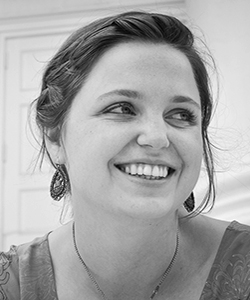
Description:
The two-day workshop revolves around the design and fabrication of geometrically differentiated hollow nodal components that can be aggregated into larger structures. Participants will design the objects with the help of particle-spring models. They are made from an acrylic/plaster composite material that is cast into pre-tensioned hyper-elastic membranes that act as dynamic and flexible formwork. Since such a delicate formwork cannot withstand high pressure, only a minimum amount of material is cast. Subsequently the formwork is rotomoulded. The slow rotational movement distributes the material evenly across the formwork surface. The resulting lightweight components stay hollow or act as permanent formwork for a second cast. Participants will design a spatial structure consisting of multiple elements and explore the geometric solution space of hyper-elastic membranes as formwork through digital simulation. At the second day we will fabricate a selection of elements through rotomoulding. The result of the workshop will be a physical prototype and a design proposal of a spatial structure represented through drawings and diagrams.
Prior to the workshop the workshop leaders will prepare and provide:
- A fully functioning Grasshopper/Kangaroo definition. Participants are not expected to develop any definitions but rather use them for design exploration.
- A workflow to generate drawings and diagrams from simulation models.
- A formwork system consisting of a falsework for pre-tensioning. The hyper-elastic formwork and the joint details.
- A well-tested material for casting and rotomoulding.
- A rotomoulding machine.
- A joint system for assembling the elements into a larger prototype.
- Detailed information about necessary software and plugin configuration.
The workshop is embedded into a larger research project on novel robotic manufacturing techniques for concrete casting. We seek to challenge conventional formwork systems through the integration of rotomoulding into the casting process. The rotational movement and the reduced hydrostatic pressure allow for material efficient and geometrically differentiated formwork. Pre-tensioned membranes replace material intensive milling of foam or tailoring of textile formwork. Such a material system comes with geometric limitations and constraints that will be explored through digital simulation of the pre-tensioning process. The prototyping part of the workshop allows for a comparison between the simulated digital geometry and the materialized version. The workshop guides participants though the process of design, analysis, and manufacturing of complex shapes.
Expected Skill Level: Basic knowledge of Rhino and Grasshopper is required, basic knowledge of Kangaroo and physical modelling skills are desirable.
Tutors:
Oliver Tessmann, Samim Mehdizadeh and Annie-Locke Scherer



Bio:
Oliver Tessmann is an architect and professor at the Technische Universität Darmstadt where he is heading the Digital Design Unit (DDU). His teaching and research revolves around computational design and digital manufacturing and robotics in architecture. From 2012 – 2015 he has been assistant professor in the School of Architecture of the Royal Institute of Technology (KTH) in Stockholm. From 2008 – 2011 he has been a guest professor at Staedelschule Architecture Class (SAC) and worked with the engineering office Bollinger + Grohmann in Frankfurt. In 2008 Oliver Tessmann received a doctoral degree at the University of Kassel. He conducted research in the field of “Collaborative Design Procedures for Architects and Engineers”. His work has been published and exhibited in Europe, Asia and the US.
Samim Mehdizadeh is a research fellow at the Digital Design Unit (DDU) in Darmstadt. He graduated at the Technische Universität Darmstadt, Digital Design Unit in 2018. His research-in-design thesis explored the rotomoulding technique for concrete components and the novel design potentials of the material system in architecture. In 2016 and 2017 Samim has been working with Achim Menges (Menges-Scheffler Architekten BDA) on the stage envelopment Project on Pier 17 building in Manhattan, New York. Prior experiences in practice include the engineering office o-s-d in Frankfurt and a collaboration with the artist Thomas Bayrle. He holds a bachelor degree from the Azad University in Tehran. Samim Mehdizadeh received the Heinz-Stillger-Award for research in architectural design in 2017 for exploring roto-moulding technic in an architectural context.
Annie Locke Scherer is a doctoral researcher in the Architectural Technologies department at KTH School of Architecture. She has a Master of Architecture from the University of Michigan and a M.S. in Digital Fabrication from University of Stuttgart’s ITECH Master program. Her PhD research at KTH in Stockholm focuses on the intersection of parametric patterning, simulation, and fabrication of fabric formwork and cast concrete.
